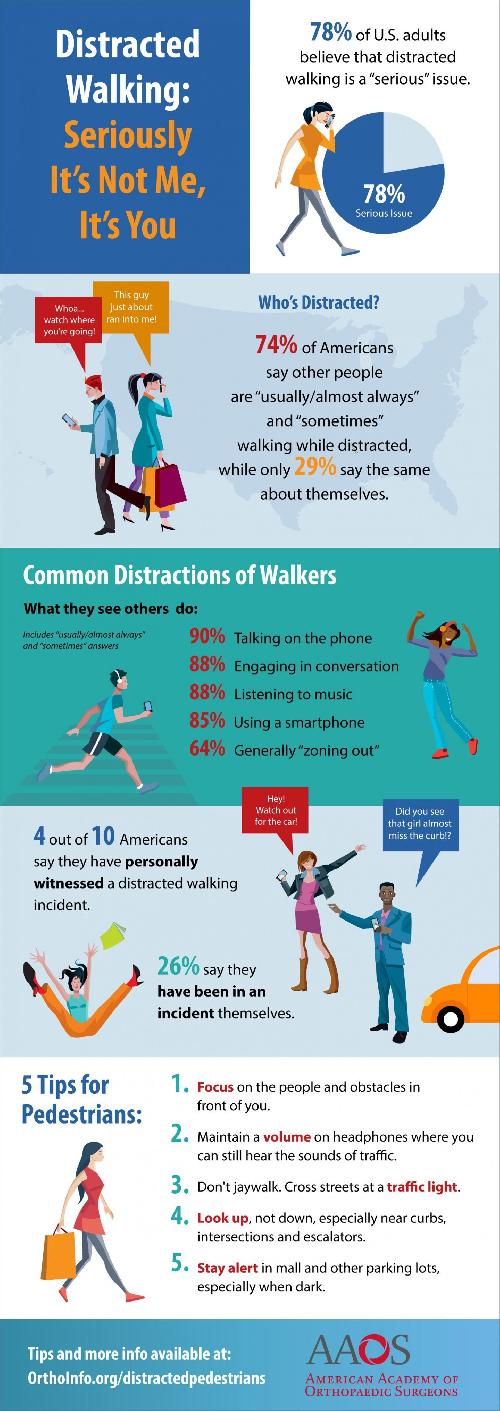When you see someone wandering all over the street because they are on the phone, it is irksome. When you have to reply to a text, not so much.
At Science 2.0 we call this phenomenon "mobile drift" but the American Academy of Orthopaedic Surgeons lumps such mobile deadwalkers under the term "distracted walking." They find that more than three quarters (78 percent) of U.S. adults believe that distracted walking is a "serious" issue; however, 74 percent of Americans say "other people" are usually or always walking while distracted, while only 29 percent say the same about themselves.
This sense of "it's not me, it's you" cuts across a range of distracted walking behaviors:

Despite the obvious risks associated with distracted walking, as many believe it is "embarrassing in a silly way" as feel it is "dangerous" (46 percent). Furthermore, 31 percent say distracted walking is "something I'm likely to do" and 22 percent think distracted walking is "funny," according to the study conducted by Ipsos Public Affairs during October 2015.
Emergency department hospital visits for injuries involving distracted pedestrians on cell phones more than doubled between 2004 and 2010, according to a 2013 study appearing in the journal Accident, Analysis&Prevention.
The survey involved more than 2,000 respondents nationally and another 4,000, total, in select urban areas, found that nearly four out of 10 Americans say they have personally witnessed a distracted walking incident, and just over a quarter (26 percent) say they have been in an incident themselves.
- Of those injured, women age 55 and over are most likely to suffer serious injuries, while Millennials, ages 18-34, are least likely to be injured while walking distracted, despite reporting higher rates of distracted walking incidents.
- The perceptions of distracted walking also differ by generation, with 70 percent of Millennials believing that distracted walking is a serious issue compared to 81 percent of those age 35 and older. Half of Millennials think distracted walking is "embarrassing - in a funny way."
- Millennials are more likely to engage in common distracted walking behaviors than older people are: texting, listening to music and talking on the phone.
- More Americans view distracted driving and impaired driving as "very" or "somewhat serious" - 96 and 95 percent, respectively.
Can we talk and walk at the same time?
One of challenges in combating distracted walking may be that Americans are overly confident in their ability to multitask. When asked why they walk distracted, 48 percent of respondents say "they just don't think about it," 28 percent feel "they can walk and do other things," and 22 percent "are busy and want to use their time productively."
Among distracted walking behaviors, 75 percent of respondents say they themselves "usually/always" or "sometimes" have "active conversations" with another person they are walking with, making this the most common distracted walking behavior people admit to doing themselves.
Perceptions vary by city, region
Additionally, 500 people were surveyed in eight markets: New York, Los Angeles, Houston, Chicago, Phoenix, Seattle, Philadelphia and Atlanta. Among those findings:
- Among these eight markets, New York City residents are most likely to view distracted walking as a serious issue (86 percent), and Seattle residents were least likely to view the issue as serious (77 percent).
- New Yorkers are more likely to say they personally walk distracted (39 percent) than walkers living in the other cities.
- Residents of Chicago and Philadelphia are most likely to see distracted walking as "dangerous" (49 percent), while those in Houston were the least likely to think it's dangerous (40 percent).





Comments